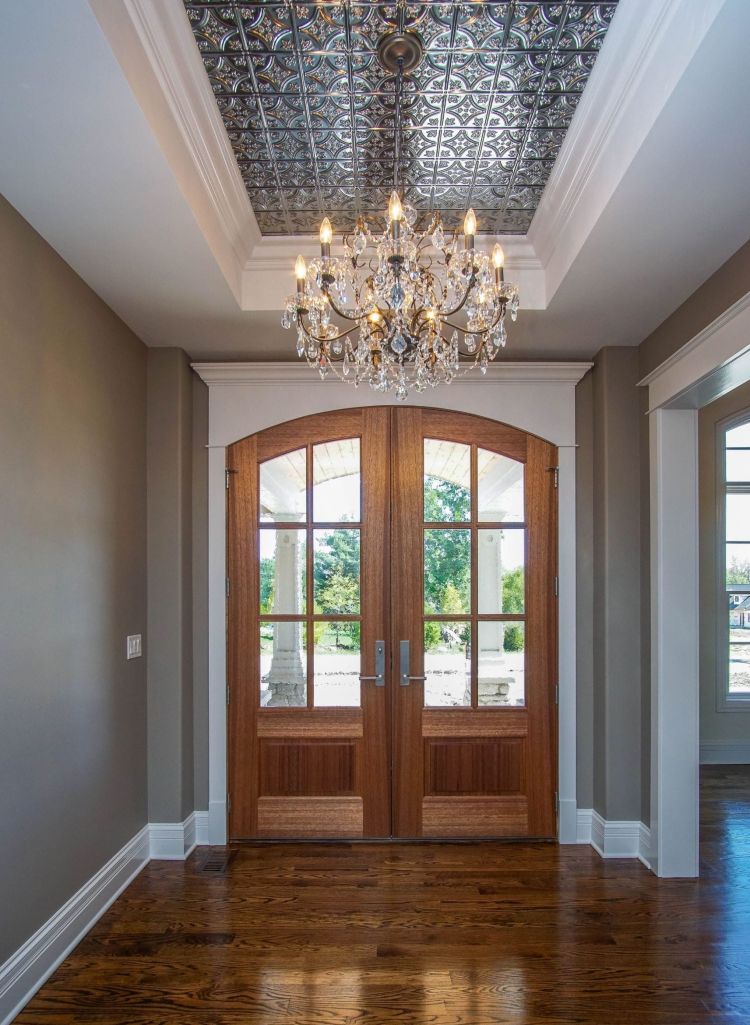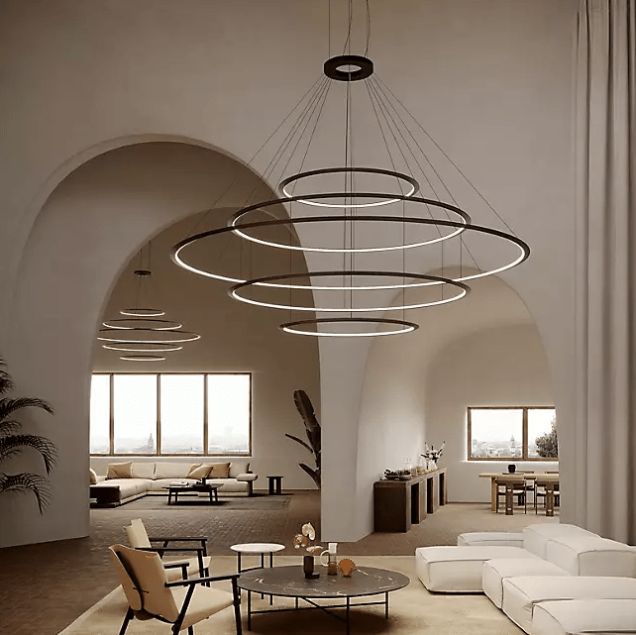Install Chandelier On High Ceiling. Installing a chandelier can transform any room, adding elegance and ambiance. However, installing a chandelier on high ceilings presents unique challenges that require careful planning and execution. In this comprehensive guide, we will cover everything you need to know about installing a chandelier on high ceilings, from selecting the right chandelier to safety considerations and installation techniques.

Why Choose a Chandelier for High Ceilings?
Chandeliers are often the focal point of a room, drawing the eye and enhancing the overall aesthetic. When you have high ceilings, a chandelier can help fill the vertical space, making the room feel more balanced and inviting. Here are some reasons why you should consider installing a chandelier in a room with high ceilings:
- Aesthetic Appeal: Chandeliers come in various styles, from traditional to modern, and can significantly enhance the decor of your space.
- Improved Lighting: A chandelier can provide both ambient and task lighting, making the room feel brighter and more inviting.
- Increased Property Value: A well-placed chandelier can add to the value of your home, appealing to potential buyers who appreciate elegant lighting fixtures.
- Personalization: Choosing a chandelier that reflects your style can help personalize your space, making it uniquely yours.
Preparing to Install a Chandelier on High Ceilings
Before you begin the installation process, there are several important factors to consider:
1. Selecting the Right Chandelier
When selecting a chandelier for a high ceiling, consider the following:
- Size: The size of the chandelier should be proportionate to the room. A general rule of thumb is to add the room’s dimensions (in feet) and convert that number to inches. For example, a room that is 15 feet by 20 feet would need a chandelier that is approximately 35 inches wide.
- Height: The height of the chandelier should be appropriate for the ceiling height. Ideally, the bottom of the chandelier should be 30 to 36 inches above a table if it’s being hung above one.
- Style: Choose a style that complements the room’s decor. Whether you prefer traditional, modern, or eclectic styles, there are countless options available.
Read too: Shiplap Ceiling in Kitchen: A Timeless Trend for a Stylish and Cozy Space
2. Tools and Materials Needed
Before starting the installation, gather the necessary tools and materials:
- Ladder (preferably adjustable for different heights)
- Drill and drill bits
- Screwdriver
- Wire cutters/strippers
- Electrical tape
- A helper (recommended for safety)
3. Safety Considerations
Safety should always be your top priority when installing a chandelier. Consider the following safety tips:
- Turn Off the Power: Always turn off the power to the existing light fixture at the circuit breaker to avoid any electrical hazards.
- Use a Stable Ladder: Ensure your ladder is stable and positioned on a flat surface. If necessary, have someone hold the ladder while you work.
- Use Proper Safety Gear: Consider wearing safety goggles and gloves to protect yourself during the installation process.
Steps to Install a Chandelier on High Ceilings
Once you’ve gathered your tools and selected your chandelier, follow these steps to successfully install it:
Step 1: Remove the Existing Fixture
If you are replacing an existing light fixture, you’ll need to remove it first:
- Turn Off the Power: Go to the circuit breaker and turn off the power to the room.
- Remove the Old Fixture: Unscrew the old fixture from the ceiling and carefully disconnect the wiring. Make a note of how the wires are connected, as you’ll need to replicate this with the new chandelier.
Step 2: Prepare the Chandelier
Before hanging the chandelier, prepare it for installation:
- Assemble the Chandelier: If your chandelier requires assembly, do this according to the manufacturer’s instructions.
- Check the Wiring: Ensure that all wiring is intact and that there are no damaged parts.
Step 3: Attach the Mounting Bracket
The next step is to attach the mounting bracket that will hold the chandelier:
- Position the Bracket: Align the mounting bracket with the electrical box in the ceiling.
- Secure the Bracket: Use screws to secure the mounting bracket in place, ensuring it is tight and secure.
Step 4: Hang the Chandelier
Now that the bracket is in place, it’s time to hang the chandelier:
- Lift the Chandelier: This step may require a helper, as chandeliers can be heavy. Lift the chandelier and align it with the mounting bracket.
- Connect the Wires: Following the notes you made earlier, connect the chandelier wires to the electrical wires in the ceiling. Typically, you will connect:
- Black (or red) wire from the chandelier to the black wire in the ceiling (hot).
- White wire from the chandelier to the white wire in the ceiling (neutral).
- Green or bare wire to the grounding wire in the ceiling.
- Secure the Connections: Use wire nuts to secure the connections, and wrap them with electrical tape for extra safety.
- Attach the Chandelier: Once the wiring is secure, carefully tuck the wires into the electrical box and attach the chandelier to the mounting bracket.
Step 5: Final Adjustments
After the chandelier is secured:
- Adjust the Height: If your chandelier has adjustable cables or chains, adjust them to your desired height.
- Check Stability: Ensure the chandelier is stable and securely attached to the ceiling.
- Install Light Bulbs: Insert the appropriate light bulbs into the chandelier.
Step 6: Restore Power and Test
Once everything is in place, it’s time to restore power:
- Turn On the Power: Go back to the circuit breaker and turn the power back on.
- Test the Chandelier: Turn on the switch to ensure the chandelier is functioning correctly. Check for any flickering lights or other issues.
Troubleshooting Common Issues
After installing a chandelier on a high ceiling, you may encounter some common issues. Here are a few troubleshooting tips:
1. Flickering Lights
If your chandelier flickers, it may indicate a loose connection or an incompatible bulb. Check the wiring connections and ensure you’re using the correct type of bulb.
2. Insufficient Light
If the chandelier doesn’t provide enough light, consider adding more bulbs or using higher wattage bulbs, provided they are compatible with the fixture.
3. Chandelier Sways or Moves
If your chandelier sways or feels loose, double-check that all connections are secure and that the mounting bracket is tightly fastened.
Maintenance Tips for Your Chandelier
Once your chandelier is installed, proper maintenance is key to keeping it looking its best:
- Regular Cleaning: Dust your chandelier regularly with a soft cloth. For crystal chandeliers, use a mixture of water and vinegar to clean the crystals without damaging them.
- Check the Bulbs: Periodically check the bulbs and replace any that are burnt out.
- Inspect Wiring: Every few months, inspect the wiring and connections to ensure everything remains secure.
When to Hire a Professional
While installing a chandelier can be a DIY project, there are times when it’s best to hire a professional:
- Complex Installations: If your chandelier requires extensive electrical work or modifications to the existing wiring, hiring a licensed electrician is advisable.
- Heavy Fixtures: For large and heavy chandeliers, it may be safer to have professionals handle the installation to avoid accidents.
- Lack of Experience: If you are unsure about your skills, hiring a professional can ensure that the job is done safely and correctly.
Conclusion
Installing a chandelier on high ceilings can enhance the beauty and functionality of your space, but it requires careful planning and execution. By following the steps outlined in this guide, you can successfully install a chandelier that complements your decor and adds elegance to your home. Remember to prioritize safety and consider hiring a professional if the installation becomes too complex.


















